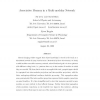Free Online Productivity Tools
i2Speak
i2Symbol
i2OCR
iTex2Img
iWeb2Print
iWeb2Shot
i2Type
iPdf2Split
iPdf2Merge
i2Bopomofo
i2Arabic
i2Style
i2Image
i2PDF
iLatex2Rtf
Sci2ools
NIPS
1997
1997
Multi-modular Associative Memory
Recent imaging studies suggest that object knowledge is stored in the brain as a distributed network of many cortical areas. Motivated by these observations, we study a multi-modular associative memory network, whose functional goal is to store patterns with di erent coding levels, i.e., patterns that vary in the number of modules in which they are encoded. We show that in order to accomplish this task, synaptic inputs should be segregated into intra-modular projections and inter-modular projections, with the latter undergoing additional nonlinear dendritic processing. This segregation makes sense anatomically if the inter-modular projections represent distal synaptic connections on apical dendrites. It is then straightforward to show that memories encoded in more modules are more resilient to focal a erent damage. Further hierarchical segregation of inter-modular connections on the dendritic tree improves this resilience, allowing memory retrieval from input to just one of the module...
Distal Synaptic Connections | Inter-modular Projections | Multi-modular Associative Memory | NIPS 1997 | NIPS 2007 |
| Added | 01 Nov 2010 |
| Updated | 01 Nov 2010 |
| Type | Conference |
| Year | 1997 |
| Where | NIPS |
| Authors | Nir Levy, David Horn, Eytan Ruppin |
Comments (0)

